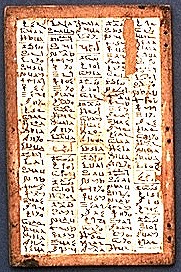
Eine kursive Schrift, die sich aus dem Hieratischen entwickelte und die sie schließlich, außer für religiöse Texte, etwa von der 26. Dynastie an ersetzte. Der griechische Begriff bedeutet '(Schrift des) Volkes' und wurde erstmals von Herodot benutzt. Zu seiner Zeit wurde Demotisch hauptsächlich für Zwecke der Verwaltung und des Rechts verwendet; für religiöse Texte wurden immer noch Hieroglyphen verwendet. Das Demotisch durchlief eine jahrhundertelange Entwicklung. Obwohl die Veränderungen nach und nach stattfanden, wurden folgende Phasen festgestellt:
- Frühdemotisch, das von der 26. Dynastie bis zum Beginn der Ptolemäerzeit verwendet wurde.
- Mitteldemotisch, das während der Ptolemäerzeit verwendet wurde; zu dieser Zeit wurden auch religiöse und funeräre Texte in Demotisch geschrieben, beispielsweise das Einbalsamierungsritual für den Apisstier. Es wurde neben Griechisch als offizielle Sprache verwendet.
- Spätdemotisch, das in der Römerzeit verwendet wurde; der späteste datierte demotische Text ist ein Graffito auf Philae aus dem Jahr 452 n. Chr.
Demotische Texte konnten auf alle Oberflächen geschrieben werden. Neben Papyri gibt es Ostraka und Holzetiketten, beispielsweise Mumienetiketten. Demotische Texte erscheinen, wenn auch nur gelegentlich, auch auf Stelen. Ein berühmtes Beispiel ist der Stein von Rosette, auf dem Demotisch neben Hieroglyphen und Griechisch erscheint. Eine Anzahl demotischer Zeichen wurden in das koptische Alphabet übernommen für Laute, für die das griechische Alphabet keine Zeichen besaß.
